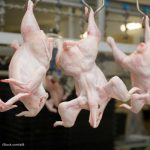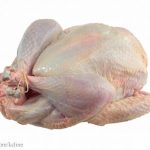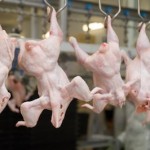According to researchers at the University of Liverpool, a mass poultry vaccination program in the UK has led to a dramatic decrease in the number of Salmonella cases since the late 1990s. There are about 6 million cases of salmonellosis in the European Union every year. Salmonella infections rose by epidemic proportions between 1981 and 1991 in the UK, increasing by 170% during that time period. Control measures were put in place, including compulsory slaughter of poultry infected with Salmonella, disinfection procedures, and movement restrictions. In 1994, the industry began a voluntary program for vaccinating chickens in breeding flocks. The same program was extended to laying flocks in 1998. The Lion Quality Code of Practice was launched in 1998. It includes the vaccination … [Read more...]
Poultry Vaccination Programs in UK Lead to Dramatic Decrease in Salmonella Infections
Campylobacter Infections in Poultry Processing Workers
The Center for Disease Control and Prevention's Emerging Infectious Diseases journal has published a study looking at Campylobacter infections among poultry processing workers. They found 29 cases of lab-diagnosed Campylobacter infections during a three year period from January 2008 to May 2011. Campylobacter is common in poultry. Infections sicken an estimated 2.4 million people every year. Most people get sick by eating undercooked poultry or improper handling of raw poultry. A recent study published in BMC Microbiology found Campylobacter bacteria in 41% of boneless, skinless chicken breast samples. Researchers studied one poultry plant in Virginia. It processed 300,000 birds every day. Of the 29 people who were diagnosed with Campylobacter infections, 23 were infected with C. … [Read more...]
Maryland Bans Arsenic in Chicken Feed
Last May, Food Poisoning Bulletin reported on the state of Maryland banning the use of arsenic in chicken feed. That bill became law on January 1, 2013. Poultry farmers have used arsenic in chicken feed since the 1940s. It treats the disease coccidiosis, which can cause anemia and diarrhea and restricts growth. The FDA approved roxarsone (3-Nitro-W), an arsenic-based drug, for use in chicken feed in 1944. Chicks gain weight faster when fed that product, and chicken flesh was pinker. The FDA approved the use of roxarsone to promote growth and improve chicken flesh pigmentation in 1951. But new scientific research has found that arsenic in poultry feed poses a risk to people that is much higher than originally thought. Chronic arsenic exposure is associated with increased bladder, … [Read more...]
Gold’n Plump Sues Supplier of Ingredient Lacking USDA Approval
Goldn’n Plump Poultry Inc. of St. Cloud, Minn. is suing a supplier whose delivery of a product not approved for use in poultry cost the company at least $50,000. Wenda America of Naperville, Ill. is named as the defendant in the suit filed December 28 in Stearns County, Minnesota District Court. According to the suit, Gold’n Plump had been purchasing Wenda’s WendaPhos 600 for use in some of its marinated chicken products since 2011. In May and June of 2012, Gold’d Plump received shipments of the product and discovered that, although all of the shipment was labelled WendaPhos 600, some of it was actually another product WendaPhos FI, which is not approved for use in poultry products by the US Department of Agriculture (USDA). Gold’n Plump workers noticed something was amiss when … [Read more...]
Study Finds Plant Oils Cut Salmonella in Poultry
A study conducted at the University of Georgia and published in the May 2013 issue of Food Control has found that adding a blend of essential oils to chicken's water can cut Salmonella contamination. Salmonella bacteria cause about 1 million cases of foodborne illness in this country every year. And the cost of Salmonella enterica infections is $3.3 billion every year. Poultry is a common source of the pathogenic bacteria. There were several Salmonella outbreaks linked to live poultry in the United States last year. And the combination of Salmonella and poultry is the fourth most likely combination that causes foodborne illness in this country. In the study, scientists added essential oils from thyme, oregano, and eucalpytol to the poultry's water source. Those oils have … [Read more...]
Tyson Blasts CDC Report On Chlorine Leak
Tyson Foods Inc. is blasting a report by the Centers for Disease Control and Prevention (CDC) about an accident involving a chlorine gas leak at the company’s plant in Springdale Ark., in June 2011. The incident occurred when a worker at the poultry processing plant began to pour sodium hypochlorite into a 55-gallon drum that contained residual acidic antimicrobial solution. When the two chemicals reacted, a greenish-yellow cloud of chlorine gas was released. Eventually, the toxic gas spread throughout the plant where 600 workers were on the job. The plant was immediately evacuated, but not before some workers were injured. Chlorine is a respiratory irritant that can produce mild symptoms such as eye, nose, and throat irritation or severe symptoms such as lung inflammation which can … [Read more...]
Don’t Wash That Bird!
Washing chickens and turkeys before cooking is a common practice in many kitchens that is completely unnecessary and potentially dangerous. Salmonella, Campylobacter, and other pathogenic and potentially deadly bacteria are always going to be on raw chicken. In fact, Campylobacter is found on almost 50% of commercially available whole chickens. Thorough cooking kills those bacteria and makes the meat safe. Rinsing the raw chicken contaminates your sink, countertop, utensils, walls, floors, and everything else in the kitchen (including you) near the sink. Marjorie Davidson, a consumer educator at the FDA, says, "washing raw meat and poultry before cooking makes it more likely for bacteria to spread to areas around the sink and countertops." That will lead to cross-contamination of other … [Read more...]
Former Poultry Inspector Petitions Against USDA Plan
Phyllis McKelvey, a former USDA poultry inspector, has started a petition on Change.org against HIMP, the USDA's new plan to reform poultry inspection. The program, called HACCP-based Inspection Models Project, has been criticized by many organizations, including the Consumer Federation of America, the National Consumer League, and Food & Water Watch, who believe it will lower quality and standards in the poultry industry. McKelvey says, "I have dedicated my professional life to protecting the integrity of the nation's food supply and I believe the USDA's plan to decrease poultry inspection and increase line speed is bad for consumers and poultry plant workers." The model reduces the number of USDA inspectors and also increases line speeds. Workers will have 1/3 of a second to … [Read more...]
Consumer Groups Urge USDA to Withdraw Poultry Slaughter Proposal
A coalition of 23 consumer, labor, public health, and civil rights groups have sent a letter to Secretary Tom Vilsack. They are urging the U.S. Department of Agriculture (USDA) to withdraw its proposal that increases poultry processing line speeds and removes hundreds of federal inspectors from poultry processing plants. That proposal, called HACCP-based Inspection Models Project (HIMP) has been criticized by many consumer groups. The letter states that USDA's Food Safety and Inspection Service (FSIS) developed the proposal with limited input and did not consult with its inspection advisory committee. The agency did also not hold public meetings on this issue, unlike previous agency proposals. The coalition has several concerns with this proposal. Line speed increases are a concern, … [Read more...]
Campylobacter in Skinless, Boneless Chicken
A study published in BMC Microbiology looked at the prevalence of Campylobacter in skinless, boneless chicken breasts, tenderloins, and thighs. The meat was purchased in food stores in Alabama from 2005 to 2011. Campylobacter bacteria was found in 41% of the meat samples. This study reinforces the fact that consumers should avoid cross-contamination with raw poultry and should cook chicken to well-done, or 165 degrees F. Researchers found that there was no statistical difference over the years. They also found that seasonality did not affect the presence of Campylobacter jejuni, but did affect the prevalence of Campylobacter coli. And the prevalence of C. coli varied by brand, plant, season, state, store, and year, but the presence of C. jejuni varied by brand, product, state, and … [Read more...]












